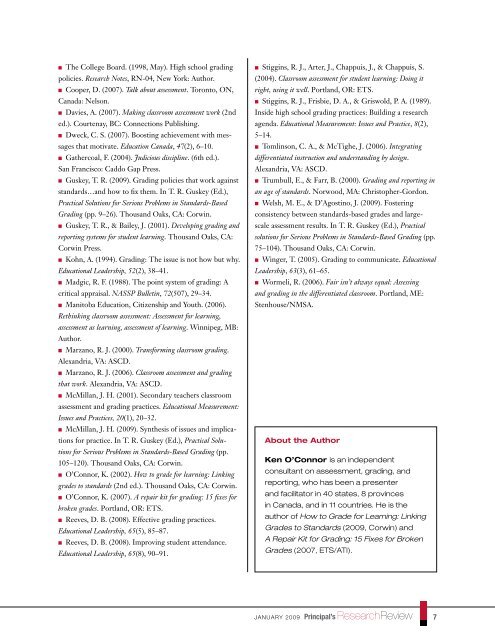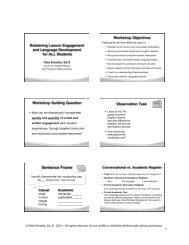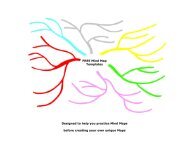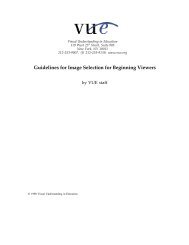Reforming Grading Practices in Secondary Schools - eStaffRoom
Reforming Grading Practices in Secondary Schools - eStaffRoom
Reforming Grading Practices in Secondary Schools - eStaffRoom
You also want an ePaper? Increase the reach of your titles
YUMPU automatically turns print PDFs into web optimized ePapers that Google loves.
n The College Board. (1998, May). High school grad<strong>in</strong>g<br />
policies. Research Notes, RN-04, New York: Author.<br />
n Cooper, D. (2007). Talk about assessment. Toronto, ON,<br />
Canada: Nelson.<br />
n Davies, A. (2007). Mak<strong>in</strong>g classroom assessment work (2nd<br />
ed.). Courtenay, BC: Connections Publish<strong>in</strong>g.<br />
n Dweck, C. S. (2007). Boost<strong>in</strong>g achievement with messages<br />
that motivate. Education Canada, 47(2), 6–10.<br />
n Gathercoal, F. (2004). Judicious discipl<strong>in</strong>e. (6th ed.).<br />
San Francisco: Caddo Gap Press.<br />
n Guskey, T. R. (2009). <strong>Grad<strong>in</strong>g</strong> policies that work aga<strong>in</strong>st<br />
standards…and how to fix them. In T. R. Guskey (Ed.),<br />
Practical Solutions for Serious Problems <strong>in</strong> Standards-Based<br />
<strong>Grad<strong>in</strong>g</strong> (pp. 9–26). Thousand Oaks, CA: Corw<strong>in</strong>.<br />
n Guskey, T. R., & Bailey, J. (2001). Develop<strong>in</strong>g grad<strong>in</strong>g and<br />
report<strong>in</strong>g systems for student learn<strong>in</strong>g. Thousand Oaks, CA:<br />
Corw<strong>in</strong> Press.<br />
n Kohn, A. (1994). <strong>Grad<strong>in</strong>g</strong>: The issue is not how but why.<br />
Educational Leadership, 52(2), 38–41.<br />
n Madgic, R. F. (1988). The po<strong>in</strong>t system of grad<strong>in</strong>g: A<br />
critical appraisal. NASSP Bullet<strong>in</strong>, 72(507), 29–34.<br />
n Manitoba Education, Citizenship and Youth. (2006).<br />
Reth<strong>in</strong>k<strong>in</strong>g classroom assessment: Assessment for learn<strong>in</strong>g,<br />
assessment as learn<strong>in</strong>g, assessment of learn<strong>in</strong>g. W<strong>in</strong>nipeg, MB:<br />
Author.<br />
n Marzano, R. J. (2000). Transform<strong>in</strong>g classroom grad<strong>in</strong>g.<br />
Alexandria, VA: ASCD.<br />
n Marzano, R. J. (2006). Classroom assessment and grad<strong>in</strong>g<br />
that work. Alexandria, VA: ASCD.<br />
n McMillan, J. H. (2001). <strong>Secondary</strong> teachers classroom<br />
assessment and grad<strong>in</strong>g practices. Educational Measurement:<br />
Issues and <strong>Practices</strong>, 20(1), 20–32.<br />
n McMillan, J. H. (2009). Synthesis of issues and implications<br />
for practice. In T. R. Guskey (Ed.), Practical Solutions<br />
for Serious Problems <strong>in</strong> Standards-Based <strong>Grad<strong>in</strong>g</strong> (pp.<br />
105–120). Thousand Oaks, CA: Corw<strong>in</strong>.<br />
n O’Connor, K. (2002). How to grade for learn<strong>in</strong>g: L<strong>in</strong>k<strong>in</strong>g<br />
grades to standards (2nd ed.). Thousand Oaks, CA: Corw<strong>in</strong>.<br />
n O’Connor, K. (2007). A repair kit for grad<strong>in</strong>g: 15 fixes for<br />
broken grades. Portland, OR: ETS.<br />
n Reeves, D. B. (2008). Effective grad<strong>in</strong>g practices.<br />
Educational Leadership, 65(5), 85–87.<br />
n Reeves, D. B. (2008). Improv<strong>in</strong>g student attendance.<br />
Educational Leadership, 65(8), 90–91.<br />
n Stigg<strong>in</strong>s, R. J., Arter, J., Chappuis, J., & Chappuis, S.<br />
(2004). Classroom assessment for student learn<strong>in</strong>g: Do<strong>in</strong>g it<br />
right, us<strong>in</strong>g it well. Portland, OR: ETS.<br />
n Stigg<strong>in</strong>s, R. J., Frisbie, D. A., & Griswold, P. A. (1989).<br />
Inside high school grad<strong>in</strong>g practices: Build<strong>in</strong>g a research<br />
agenda. Educational Measurement: Issues and Practice, 8(2),<br />
5–14.<br />
n Toml<strong>in</strong>son, C. A., & McTighe, J. (2006). Integrat<strong>in</strong>g<br />
differentiated <strong>in</strong>struction and understand<strong>in</strong>g by design.<br />
Alexandria, VA: ASCD.<br />
n Trumbull, E., & Farr, B. (2000). <strong>Grad<strong>in</strong>g</strong> and report<strong>in</strong>g <strong>in</strong><br />
an age of standards. Norwood, MA: Christopher-Gordon.<br />
n Welsh, M. E., & D’Agost<strong>in</strong>o, J. (2009). Foster<strong>in</strong>g<br />
consistency between standards-based grades and largescale<br />
assessment results. In T. R. Guskey (Ed.), Practical<br />
solutions for Serious Problems <strong>in</strong> Standards-Based <strong>Grad<strong>in</strong>g</strong> (pp.<br />
75–104). Thousand Oaks, CA: Corw<strong>in</strong>.<br />
n W<strong>in</strong>ger, T. (2005). <strong>Grad<strong>in</strong>g</strong> to communicate. Educational<br />
Leadership, 63(3), 61–65.<br />
n Wormeli, R. (2006). Fair isn’t always equal: Assess<strong>in</strong>g<br />
and grad<strong>in</strong>g <strong>in</strong> the differentiated classroom. Portland, ME:<br />
Stenhouse/NMSA.<br />
About the Author<br />
Ken O’Connor is an <strong>in</strong>dependent<br />
consultant on assessment, grad<strong>in</strong>g, and<br />
report<strong>in</strong>g, who has been a presenter<br />
and facilitator <strong>in</strong> 40 states, 8 prov<strong>in</strong>ces<br />
<strong>in</strong> Canada, and <strong>in</strong> 11 countries. He is the<br />
author of How to Grade for Learn<strong>in</strong>g: L<strong>in</strong>k<strong>in</strong>g<br />
Grades to Standards (2009, Corw<strong>in</strong>) and<br />
A Repair Kit for <strong>Grad<strong>in</strong>g</strong>: 15 Fixes for Broken<br />
Grades (2007, ETS/ATI).<br />
january 2009 Pr<strong>in</strong>cipal’s ResearchReview<br />
7






